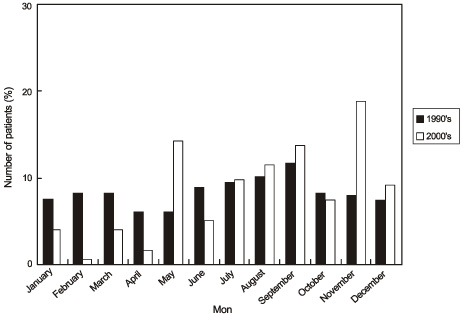J Korean Ophthalmol Soc.
2012 Jan;53(1):145-150. 10.3341/jkos.2012.53.1.145.
The Changes in the Clinical Features of Pediatric Ocular Trauma
- Affiliations
-
- 1Department of Ophthalmology, Chonnam National University Medical School, Gwangju, Korea. opheye@hanmail.net
- KMID: 2215257
- DOI: http://doi.org/10.3341/jkos.2012.53.1.145
Abstract
- PURPOSE
To review the recent changes in the clinical features of ocular trauma in pediatric patients younger than 15 years of age.
METHODS
We performed a retrospective study using clinical records of 147 patients from 1993 to 1998, and those of 175 pediatric patients younger than 15 years old from 2003 to 2007.
RESULTS
The most common cause of pediatric ocular trauma in the 2000's was fist blow (66 patients, 37.7%), while that in the 1990's was trauma by stick or branch (20 patients, 13.6%) (p < 0.001). The number of patients with perforating ocular trauma decreased to 25 patients (14.3%) in the 2000's, from 55 patients (37.4%) in the 1990's (p < 0.001). The number of patients who received surgery due to ocular trauma was 87 (59.2%) in the 1990's, decreasing to 53 (30.3%) in the 2000's (p < 0.001). The number of orbital wall reconstructions increased from 6 patients (6.9%) in the 1990's to 20 patients (37.7%) in the 2000's, a statistically significant increase (p < 0.001).
CONCLUSIONS
Perforating ocular trauma decreased in children in the studied age range, but non-perforating injuries caused by fist blow were increased in the years studied. These results indicate that management or establishment of preventive for pediatric violence will be helpful to lower the frequency of pediatric ocular traumas.
Figure
Reference
-
1. Parver LM. Eye trauma. The neglected disorder. Arch Ophthalmol. 1986. 104:1452–1453.2. Serrano JC, Chalela P, Arias JD. Epidemiology of childhood ocular trauma in a northeastern Colombian region. Arch Ophthalmol. 2003. 121:1439–1445.3. Cascairo MA, Mazow ML, Prager TC. Pediatric ocular trauma: a retrospective survey. J Pediatr Ophthalmol Strabismus. 1994. 31:312–317.4. Nelson LB, Wilson TW, Jeffers JB. Eye injuries in childhood: demography, etiology, and prevention. Pediatrics. 1989. 84:438–441.5. Grin TR, Nelson LB, Jeffers JB. Eye injuries in childhood. Pediatrics. 1987. 80:13–17.6. Kim JH, Yu YS. Clinical course and predictive factors of final visual acuity in children with penetrating ocular trauma. J Korean Ophthalmol Soc. 2003. 44:699–705.7. Sim HS, Song SJ, Choi CY, et al. Comparison of clinical appearance of pediatric ocular injury, according to grade level. J Korean Ophthalmol Soc. 2008. 49:148–157.8. Park YG, Lee CS, Kim CR, Kim JB. Clinical evaluation of the pediatric ocular trauma. J Korean Ophthalmol Soc. 2000. 41:993–999.9. Shin WK, Lee SK, Kim BC. Clinical analysis of children's perforating eye injuries in middle western coast of Korea. J Korean Ophthalmol Soc. 1995. 36:91–96.10. Chung SM, Choi JY. A clinical study of penetrating ocular injuries. J Korean Ophthalmol Soc. 1997. 38:491–498.11. Jang Y, Oh S, Ji NC. A clinical observation of ocular injuries of inpatients. J Korean Ophthalmol Soc. 1993. 34:257–263.12. Oh CS, Ahn Y. Clinical picture of the pediatric ocular trauma. J Korean Ophthalmol Soc. 2001. 42:119–126.13. Werner S. On injuries to the eye in children. Acta Ophthalmol (Copenh). 1952. 30:97–104.14. Niiranen M, Raivo I. Eye injuries in children. Br J Ophthalmol. 1981. 65:436–438.15. Scharf J, Zonis S. Perforating injuries of the eye in childhood. J Pediatr Ophthalmol. 1976. 13:326–328.16. Brophy M, Sinclair SA, Hostetler SG, Xiang H. Pediatric eye injury-related hospitalizations in the United States. Pediatrics. 2006. 117:e1263–e1271.17. Park CS, Lee DY, Yoon HS. A clinical study of posterior segment injuries of non-penetrating ocular trauma. J Korean Ophthalmol Soc. 1998. 39:2816–2821.18. Kim HJ, Kwon JY. A clinical observation of perforating ocular injuries. J Korean Ophthalmol Soc. 1989. 30:123–130.19. Jang SG, Lee SJ. Statistical evaluation for perforating ocular injuries. J Korean Ophthalmol Soc. 1988. 29:921–929.20. De Juan E, Sternberg P Jr, Michels RG. Penetrating ocular injuries. Types of injuries and visual results. Ophthalmology. 1983. 90:1318–1322.21. Hiatt RL, Bruce JA. Study of corneoscleral laceration. Ann Ophthalmol. 1978. 10:1725–1728.22. Young DW, Little JM. Pellet-gun eye injuries. Can J Ophthalmol. 1985. 20:9–10.
- Full Text Links
- Actions
-
Cited
- CITED
-
- Close
- Share
- Similar articles
-
- Clinical Picture of the Pediatric Ocular Trauma
- The Clinical Features of Geriatric Ocular Trauma in a Regional Emergency Medical Center
- Pulsatile Ocular Blood Flow Measurements in Ocular Trauma Patients
- A Clinical Study of Pediatric Ocular Injuries through Emergency Room
- Analysis of Ocular Complications and Blowout Fracture in Orbital Blunt Trauma



